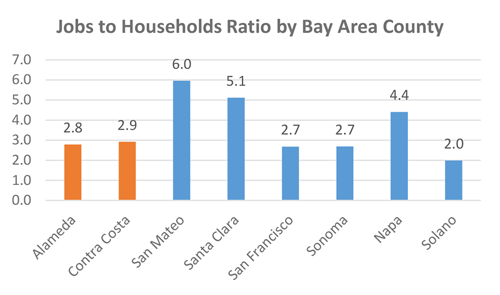In early August, East Bay EDA’s Economic Development Directors’ (EDD) Council was invited to provide input and feedback on the Economy element of Plan Bay Area 2050 Draft Blueprint, a long-range plan developed by the Metropolitan Transportation Commission (MTC) and the Association of Bay Area Governments (ABAG) to direct future investments for the nine-county San Francisco Bay Area. Plan Bay Area 2050 will focus on four key issues—the economy, the environment, housing and transportation—and will identify a path to make the Bay Area more equitable for all residents and more resilient in the face of unexpected challenges.
The meeting with our EDD Council focused on the draft Economy element, which presents two objectives: “Improving Economic Mobility” and “Shifting Location of Jobs.” These objectives are central to improving livelihoods for the East Bay’s 2.8 million residents through providing quality job opportunities, shared prosperity, and a sustainable quality of life for all residents and workers. While the Bay Area’s economic growth since the Great Recession remains impressive, it has also presented many challenges, including the vast displacement of workers, a stratified workforce, high housing prices, long and costly commutes, and a host of environmental issues. Additionally, the jobs boom experienced mostly in the West Bay and South Bay since then has not been shared by all communities, with the East Bay contributing most of the housing production in the Bay Area but only seeing modest job growth. As shown in the figure below, Alameda and Contra Costa counties’ had jobs to housing ratios far below San Mateo, Santa Clara and Napa counties.

To ameliorate these imbalances, our EDD Council underscored the importance of the East Bay as a central location for accommodating future employment growth, including more aggressive public investment to attract and retain quality and stable job opportunities that will better connect housing to jobs, strengthen critical goods movement infrastructure in the East Bay, and provide the seamless connectivity, worker equity, and emissions reductions that Plan Bay Area 2050 seeks.
The strategies contributed by East Bay EDA and the EDD Council include:
- Incentivizing the strategic placement of public institutions and sector-based incubator programs to better align employers with the local workforce
- Retaining key industrial lands by providing supportive resources for the creation of Priority Production Areas
- Investments in advanced manufacturing and related job training activities
- Allowing greater commercial densities in growth geographies beyond the urban core
- Expanding physical and broadband infrastructure in economically distressed areas through public-private partnerships
- Providing regional resources to promote trade and investment activity, including the implementation of federal opportunity zones, and foreign trade zones (FTZ)
- Providing catalytic job-generating funding for the redevelopment of aging industrial stock in the East Bay
The East Bay’s diverse and talented workforce, as well as central location in the Northern California megaregion are key assets that cannot be taken for granted. We have an extensive physical infrastructure which supports exports and goods movement with direct access to domestic and international markets. The East Bay is home to three national laboratories contributing to the Bay Area’s innovation ecosystem, and two global ports that support significant employment and investment throughout the Bay Area. Therefore, making investments to further strengthen job creation, workforce accessibility, and infrastructure in the East Bay are not just a benefit to the East Bay, but also critical to sustaining the Bay Area’s economic growth and addressing the future challenges ahead.
The Metropolitan Transportation Commission and the Association of Bay Area Governments are expected to adopt Plan Bay Area 2050 in the summer of 2021. Before the Plan is adopted in 2021, MTC and ABAG, along with partner organizations such as East Bay EDA, will create an implementation plan that will advance the strategies outlined in Plan Bay Area 2050.

